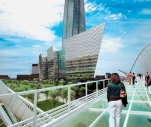Okhta`s Nerves of Steel

The City Court of Saint Petersburg responding the protests of some civic organizations has justified the height the Okhta Center, which is set to rise up to 403 meters. According to the design, in Minor Okhta location, the St. Petersburg’s industrial zone, there will be a business center with well-developed public infrastructure comprising contemporary art museum, center for the performing arts, stadium, year-round skating rink, swimming pool, library, sport facilities, retail and dining zone. The high-rise building featuring a generally accessible observation deck at its apex will dominate the area. The works are already being performed, and the challenge is to solve a wide range of technical problems concerning reliability and safety of the skyscraper while the building is underway as well as in the course of its operation and maintenance. In particular, its structural frame of special high strength steel will be fairly unique. ArcelorMittal, which is the largest global steel company and supplier of cuttingedge technical solutions for its clients, has developed a new grade of steel specified for the Okhta Center meeting all Russian and European standards.
Steel produced by ArcelorMittal works is widely applied in the most diverse industries. That’s not only the largest steel company in terms of production volume, ArcelorMittal offers the widest range of steel grades, advanced products and solutions and state-ofthe- art technologies. Never ending development of ever more lightweight and hi-tech steels requires great scientific research work.
The company offers its clients the solutions, which help to improve the products of their own. In the 21st Century there’s no way to keep the leading positions without real craving for innovations. The ArcelorMittal’s 15 scientific research centers employing 1400 scientists and engineers operate worldwide, including Europe, USA, Canada, Brazil. These facilities play the most important role in implementation of corporate strategy of the company – to be on the frontline of the steel industry.
Innovative approaches introduce new materials creating a new type of economy, whilst solving existing problems. Steady improvement of technological and scientific solutions grants essential competitive advantages. When the company became the world largest steel producer, its scientific research activity experienced a new creative impulse. The scientists help producers to extend the potential fields of application of existing know-how making these resources more effective in the course of working on promising projects.
The R&D department of ArcelorMittal is an engine of progress for high added value segments, which ensure the greatest profit margins and rise in metallurgical production.
Clients’ needs are the key driver
ArcelorMittal is guided by one principle: “If we want to be closer to our clients, we should hear their requests ”. Working hand in hand with the clients, which presumes mutual confidence and free exchange of opinions, also stimulates scientific progress and promotes development of new products and solutions, invariably proposing competitive advantages. Scientists are the protagonists of this process, who focus on development of up-todate, more lightweight, resistant, durable safer steel grades and R&D procedures taking into account the needs of the clients.
Construction industry, undoubtedly, is the major consumer of metalware – approximately 50% of yearly steel output is assigned for construction or infrastructural projects. This is the very reason urging ArcelorMittal to focus its innovation activity on this key industrial sector. Recently, the volume of rolled steel used as building material grows considerably. Steel buildings spring up in new areas rapidly changing the established skyline.
That’s because the contemporary steel products offer a wide range of advantages helping prompt and safe erection of skyscrapers made of lightweight, economical, versatile and environmentally safe steelwork. Construction of tall buildings and facilities is the most complex task in terms of design, and it presumes application of unique metalware, which properties meet both state standards and specific high-rise industry requirements.
As architectural approach toward large-scale projects becomes ever more creative, and many countries launch really stunning hundreds-metre tall skyscrapers, the steel specifications become even more precise. The steelwork used in high-rise construction is produced from hot rolled sections with improved mechanical properties uniform throughout its thickness range.
High mechanical performance is reached through selection of appropriate chemical composition of steel, and also by carefully selected processes at the melting, casting, rolling and selftempering stage.
Full version you can download here
 Text By Elena Golubeva,
Text By Elena Golubeva,
photos by ArcelorMittal


